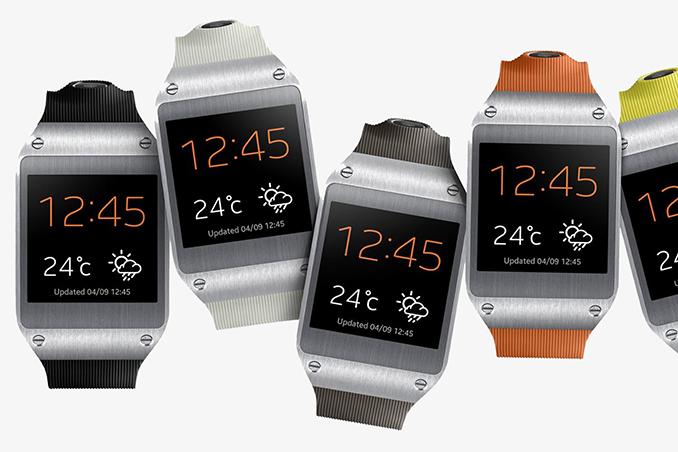Samsung Begins Tizen Rollout for Original Galaxy Gear in the US
by Brandon Chester on July 21, 2014 1:01 PM EST- Posted in
- Wearables
- Tizen
- Galaxy Gear

Samsung's original Galaxy Gear was one of the first in an initial wave of Android smartwatches. It ran Android at a time where a smartwatch was not a form factor that Google had anticipated for their operating system. Because of issues with software support and battery life, Samsung began releasing smartwatches that ran on their own Tizen operating system. Samsung also committed to updating the original Galaxy Gear from Android to Tizen. This staged rollout began earlier in May of this year, and it is now rolling out to Galaxy Gear users in United States. Samsung is promising that the update gives users access to a greater catalog of apps, along with software improvements that bring it closer to feature parity with the Gear 2 smartwatch.
The move to Tizen brings new features and additions to existing features. Many of these lie in the fitness and lifestyle capabilities of the Galaxy Gear. On Tizen the Galaxy Gear can keep track of a user's sleeping patterns using Sleep Mode, and it can keep track of workout routines in exercise mode which is an improvement over the original Android firmware which could only go as far as tracking footsteps. Unfortunately due to hardware limitations, features that utilize the heart rate monitor on the Gear 2 have not been brought over to the original Galaxy Gear
Samsung is also including a built in music player with the ability to store tracks right on the smartwatch. This is an interesting feature because it allows the Galaxy Gear to function on its own to some degree, which is a different smartwatch strategy than Google is taking with their Android Wear operating system which acts purely as an extension of your current smartphone. Another new app is the Controls application which acts as a settings app for changing brightness and volume as well as setting custom fonts, wallpapers, and icon sizes.
Beyond new apps and features, Samsung is promising that the move to Tizen brings significant increases in battery life which is great news for Galaxy Gear owners as battery life is one of the biggest concerns with smartwatches and the original Galaxy Gear running Android definitely struggled in this regard.
The update is rolling out in the United States starting today. Users will need to connect their phone to their computer and use Samsung's Kies software to download and install the update. While this isn't likely to be an issue for most users, Samsung makes a point of noting that there is no way to return to Android once the Galaxy Gear has been updated to Tizen.
Source: Samsung










12 Comments
View All Comments
Anonymous Blowhard - Monday, July 21, 2014 - link
> Samsung makes a point of noting that there is no way to return to Android once the Galaxy Gear has been updated to Tizen.Not *exactly* true ... there is a way to go back, but it's not easy and there's a brick risk.
Also expect a significant gain in battery life from XDA reports.
teddyboyd - Tuesday, December 9, 2014 - link
Samsung makes great smartwatches in the market, one of the top rated based on consumer satisfaction (see http://www.topreport.org/wearable/ for example...)name99 - Monday, July 21, 2014 - link
"Beyond new apps and features, Samsung is promising that the move to Tizen brings significant increases in battery life "So they promise longer battery life, but don't give any actual numbers. That's a good sign, right?
inighthawki - Monday, July 21, 2014 - link
You mean 'significant' isn't a number?Anonymous Blowhard - Monday, July 21, 2014 - link
Serious salt required, but I've read reports of 2-3 days battery life out of the original Gear after a Tizen flash.haukionkannel - Monday, July 21, 2014 - link
Is that the reason behind the thing that Samsung phones does not last longer, even they have quite big power-shell?They don't want to optimize their Android devices, so that Tizen looks better... No cant be... I am just paranoid, or am I?
ruggia - Monday, July 21, 2014 - link
well, do Galaxy phones gain significant battery life when they are loaded with custom roms?even more than LG/HTC/Moto phones get when they are flashed?
Alexey291 - Saturday, July 26, 2014 - link
and the answer is (in my experience with S2 and S4) is no not reallyquadrivial - Monday, July 21, 2014 - link
Tizen UI is based on the Enlightnment Foundation Libraries (the designer of them works for Samsung). EFL is written in C instead of Java eliminating a lot of inefficiencies. EFLs primary usage is in embedded systems where Android's bloated, inefficient libraries simply won't run. Despite this, EFL has a modern OpenGL ES2.0 compositor and support for wayland. In addition, the EFL evas canvas engine lazy renders so it avoids rendering a lot of what cannot be seen (a large performance boost here too).The rest is probably down to driver optimizations and streamlining the normal linux stack a bit.
jed22281 - Wednesday, July 23, 2014 - link
Much of the OS core & stock/native apps are EFL, but they ditched EFL as their primary dev env. in favour of HTML5 ages ago now. It was all rather odd at the time, Raster (the creator of EFL who's one of the main drivers of Tizen since before it was Tizen) was not happy.